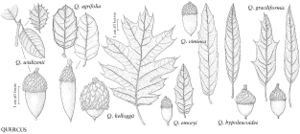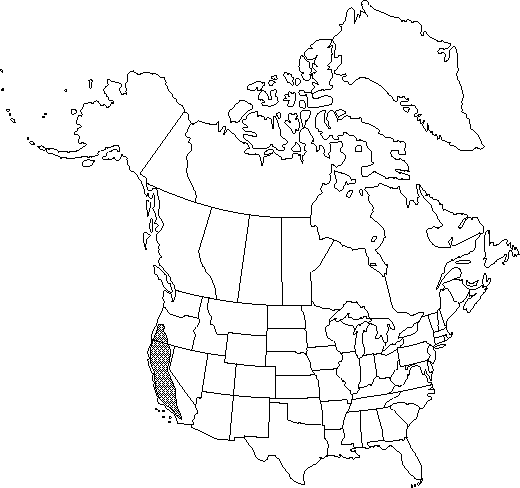FNA>Volume Importer |
FNA>Volume Importer |
| Line 30: |
Line 30: |
| | }}<!-- | | }}<!-- |
| | | | |
| − | --><span class="statement" id="st-d0_s0" data-properties="tree duration;tree some measurement"><b>Trees,</b> deciduous, to 25 m.</span> <span class="statement" id="st-d0_s1" data-properties="bark coloration;bark coloration;bark coloration;ridge width;ridge architecture or course"><b>Bark </b>dark-brown to black, ridges broad, irregular.</span> <span class="statement" id="st-d0_s2" data-properties="twig coloration;twig coloration;twig coloration;twig diameter;twig diameter;twig pubescence"><b>Twigs </b>brown to redbrown, (1.5-) 2-3.5 mm diam., glabrate.</span> <span class="statement" id="st-d0_s3" data-properties="terminal bud coloration;terminal bud shape;terminal bud some measurement;terminal bud pubescence;terminal bud pubescence;scale architecture or pubescence or shape"><b>Terminal </b>buds chestnut-brown, ovoid, 4-10 mm, glabrous or with scales ciliate on margins.</span> <span class="statement" id="st-d0_s4" data-properties="petiole some measurement;petiole pubescence;petiole pubescence;petiole pubescence"><b>Leaves:</b> petiole 10-60 mm, glabrous to densely pubescent.</span> <span class="statement" id="st-d0_s5" data-properties="leaf-blade shape;leaf-blade shape;leaf-blade shape;leaf-blade shape;leaf-blade length;leaf-blade width;base shape;base shape;base shape;base shape;lobe quantity;awn quantity;lobe shape;lobe size;lobe arrangement;sinuse depth;apex shape"><b>Leaf-</b>blade ovate or broadly elliptic to obovate, 60-200 × 40-140 mm, base cordate to obtuse, occasionally rounded, margins with 7-11 lobes and 13-45 awns, lobes acute to distally expanded, separated by deep sinuses, apex acute;</span> <span class="statement" id="st-d0_s6" data-properties="surface pubescence;surface pubescence;surface pubescence;surface pubescence;axillary tuft size;axillary tuft pubescence">surfaces abaxially glabrous with small axillary tufts of tomentum to densely pubescent, adaxially glabrous to minutely pubescent, veins raised on both surfaces.</span> <span class="statement" id="st-d0_s7" data-properties="acorn duration"><b>Acorns </b>biennial;</span> <span class="statement" id="st-d0_s8" data-properties="cup shape;cup shape;cup shape;cup width;cup width;nut quantity;outer surface pubescence;outer surface pubescence;outer surface pubescence;inner surface quantity;inner surface pubescence;scale length;scale shape;scale shape;scale shape;scale shape;scale architecture or pubescence or relief;scale relief;tip architecture or fragility">cup saucer-shaped to deeply bowl-shaped, 13-27 mm high × 20-28 mm wide, covering 1/2-2/3 nut, outer surface glabrous to sparsely puberulent, inner surface 1/3 to completely pubescent, scales more than 4 mm long, attenuate or acuminate to acute, smooth, occasionally tuberculate near base of cup, tips loose, especially at margin of cup;</span> <span class="statement" id="st-d0_s9" data-properties="nut shape;nut shape;nut shape;nut length;nut width;nut pubescence;scar diam;2n chromosome quantity">nut oblong to broadly ellipsoid, 21-34 × 14-22 mm, puberulent, especially at apex, scar diam. 5.5-10.5 mm. <b>2n</b> = 24.</span><!-- | + | --><span class="statement" id="st-undefined" data-properties=""><b>Trees,</b> deciduous, to 25 m. <b>Bark</b> dark brown to black, ridges broad, irregular. <b>Twigs</b> brown to red-brown, (1.5-)2-3.5 mm diam., glabrate. <b>Terminal</b> buds chestnut brown, ovoid, 4-10 mm, glabrous or with scales ciliate on margins. <b>Leaves</b>: petiole 10-60 mm, glabrous to densely pubescent. <b>Leaf</b> blade ovate or broadly elliptic to obovate, 60-200 × 40-140 mm, base cordate to obtuse, occasionally rounded, margins with 7-11 lobes and 13-45 awns, lobes acute to distally expanded, separated by deep sinuses, apex acute; surfaces abaxially glabrous with small axillary tufts of tomentum to densely pubescent, adaxially glabrous to minutely pubescent, veins raised on both surfaces. <b>Acorns</b> biennial; cup saucer-shaped to deeply bowl-shaped, 13-27 mm high × 20-28 mm wide, covering 1/2-2/3 nut, outer surface glabrous to sparsely puberulent, inner surface 1/3 to completely pubescent, scales more than 4 mm long, attenuate or acuminate to acute, smooth, occasionally tuberculate near base of cup, tips loose, especially at margin of cup; nut oblong to broadly ellipsoid, 21-34 × 14-22 mm, puberulent, especially at apex, scar diam. 5.5-10.5 mm. <b>2n</b> = 24.</span><!-- |
| | | | |
| | -->{{Treatment/Body | | -->{{Treatment/Body |
| Line 62: |
Line 62: |
| | |publication year=1859 | | |publication year=1859 |
| | |special status=Endemic;Selected by author to be illustrated | | |special status=Endemic;Selected by author to be illustrated |
| − | |source xml=https://jpend@bitbucket.org/aafc-mbb/fna-fine-grained-xml.git/src/287ef3db526bd807d435a3c7423ef2df1e951227/V3/V3_222.xml | + | |source xml=https://jpend@bitbucket.org/aafc-mbb/fna-data-curation.git/src/9216fc802291cd3df363fd52122300479582ede7/coarse_grained_fna_xml/V3/V3_222.xml |
| | |genus=Quercus | | |genus=Quercus |
| | |section=Quercus sect. Lobatae | | |section=Quercus sect. Lobatae |
| | |species=Quercus kelloggii | | |species=Quercus kelloggii |
| − | |2n chromosome quantity=24
| |
| − | |acorn duration=biennial
| |
| − | |apex shape=acute
| |
| − | |awn quantity=7;11
| |
| − | |axillary tuft pubescence=pubescent
| |
| − | |axillary tuft size=small
| |
| − | |bark coloration=dark-brown;black
| |
| − | |base shape=rounded;cordate;obtuse
| |
| − | |cup shape=saucer-shaped;deeply bowl-shaped
| |
| − | |cup width=×20-28;13mm;27mm
| |
| − | |inner surface pubescence=pubescent
| |
| − | |inner surface quantity=1/3
| |
| − | |leaf-blade length=60mm;200mm
| |
| − | |leaf-blade shape=broadly elliptic;obovate
| |
| − | |leaf-blade width=40mm;140mm
| |
| − | |lobe arrangement=separated
| |
| − | |lobe quantity=7;11
| |
| − | |lobe shape=acute
| |
| − | |lobe size=expanded
| |
| − | |nut length=21mm;34mm
| |
| − | |nut pubescence=puberulent
| |
| − | |nut quantity=1/2;2/3
| |
| − | |nut shape=oblong;broadly ellipsoid
| |
| − | |nut width=14mm;22mm
| |
| − | |outer surface pubescence=glabrous;sparsely puberulent
| |
| − | |petiole pubescence=glabrous;densely pubescent
| |
| − | |petiole some measurement=10mm;60mm
| |
| − | |ridge architecture or course=irregular
| |
| − | |ridge width=broad
| |
| − | |scale architecture or pubescence or relief=smooth
| |
| − | |scale architecture or pubescence or shape=ciliate
| |
| − | |scale relief=tuberculate
| |
| − | |scale shape=acuminate;acute
| |
| − | |scar diam=5.5mm;10.5mm
| |
| − | |sinuse depth=deep
| |
| − | |surface pubescence=adaxially glabrous;minutely pubescent
| |
| − | |terminal bud coloration=chestnut-brown
| |
| − | |terminal bud pubescence=with scales;glabrous
| |
| − | |terminal bud shape=ovoid
| |
| − | |terminal bud some measurement=4mm;10mm
| |
| − | |tip architecture or fragility=loose
| |
| − | |tree duration=deciduous
| |
| − | |tree some measurement=0m;25m
| |
| − | |twig coloration=brown;redbrown
| |
| − | |twig diameter=2mm;3.5mm
| |
| − | |twig pubescence=glabrate
| |
| | }}<!-- | | }}<!-- |
| | | | |
| | -->[[Category:Treatment]][[Category:Quercus sect. Lobatae]] | | -->[[Category:Treatment]][[Category:Quercus sect. Lobatae]] |
Trees, deciduous, to 25 m. Bark dark brown to black, ridges broad, irregular. Twigs brown to red-brown, (1.5-)2-3.5 mm diam., glabrate. Terminal buds chestnut brown, ovoid, 4-10 mm, glabrous or with scales ciliate on margins. Leaves: petiole 10-60 mm, glabrous to densely pubescent. Leaf blade ovate or broadly elliptic to obovate, 60-200 × 40-140 mm, base cordate to obtuse, occasionally rounded, margins with 7-11 lobes and 13-45 awns, lobes acute to distally expanded, separated by deep sinuses, apex acute; surfaces abaxially glabrous with small axillary tufts of tomentum to densely pubescent, adaxially glabrous to minutely pubescent, veins raised on both surfaces. Acorns biennial; cup saucer-shaped to deeply bowl-shaped, 13-27 mm high × 20-28 mm wide, covering 1/2-2/3 nut, outer surface glabrous to sparsely puberulent, inner surface 1/3 to completely pubescent, scales more than 4 mm long, attenuate or acuminate to acute, smooth, occasionally tuberculate near base of cup, tips loose, especially at margin of cup; nut oblong to broadly ellipsoid, 21-34 × 14-22 mm, puberulent, especially at apex, scar diam. 5.5-10.5 mm. 2n = 24.
Phenology: Flowering late spring.
Habitat: On slopes and valleys of hills and mountains
Elevation: 300-2400 m
Distribution
Calif., Oreg.
Discussion
The abundant crops of acorns from Quercus kelloggii were at one time an important food source for Native Americans.
The species reportedly hybridizes with Quercus agrifolia (= Q. ×ganderi C. B. Wolf) and Q. wislizenii (= Q. ×morehus Kellogg).
Selected References
None.

